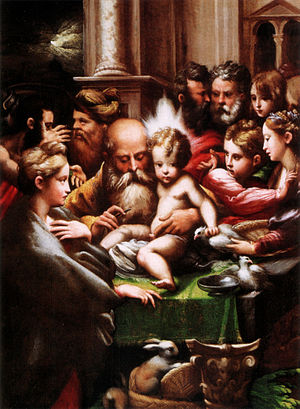- Circumcision of Jesus (Parmigianino)
-
Circumcision of Jesus 
Artist Parmigianino Year c. 1523 Type Oil on canvas Dimensions 42 cm × 31.4 cm (17 in × 12.4 in) Location Detroit Institute of Arts The Circumcision of Jesus is a painting by the Italian Mannerist artist Parmigianino, executed around 1523 and housed in the Detroit Institute of Arts, United States.
Contents
History
Late Renaissance art biographer Giorgio Vasari described a Circumcision of Jesus by Parmigianino. However, his description does not match the Detroit painting: he described a series of characters holding torches and walking which do not appear in this work.
The painting is known with certainty only starting from the 1830s, when it was part of the Russian imperial collection and was copied in a 1851 etching by J.W. Muxel. In 1917 it was acquired at Stockholm by A.B. Nordiska Kompaniet, which, a few years later, sold it to the American Axel Beskow. In 1936 he donated the work to the Detroit museum.
The painting has not been unanimously recognized as Parmigianino's until 1991[1]
The dating from around 1523 is based on comparison with other works by the Italian artist's youth and by a preparatory drawing at the Cabinet des Dessins (inv. 6390) of the Louvre museum.
Description
The work shows the circumcision of Jesus as described in the Gospel of Luke;[2] the two sacrifice doves refer to the connected act of the purification of Mary. The young Jesus, well illuminated, is the child Jesus, surrounded by a crowd of characters. At the left is a very young Madonna, with blonde eyes, similar to the Museo del Prado. Also on the left, behind her, are two character who confab on a background with the rising sun.
At the right are two rows of figures, as well as the priest who holds Jesus on the altar and, in the other hand, the ritual knife. Below, between the offers, are two small rabbits, which resembles similar details in the arch of the first chapel frescoed by Parmigianino in the church of San Giovanni Evangelista at Parma.
References
Sources
- de Castris, Pierluigi Leone (2003). Parmigianino e il manierismo europeo. Cinisello Balsamo: Silvana editoriale. pp. 236–237. ISBN 88-8215-481-5.
External links
Categories:- Parmigianino paintings
- Collections of the Detroit Institute of Arts
- 1520s paintings
Wikimedia Foundation. 2010.

